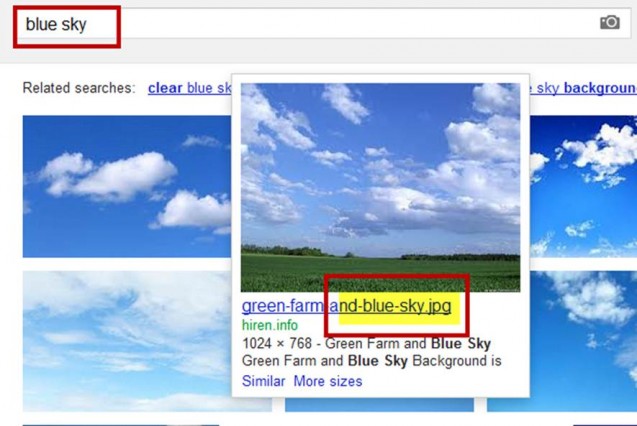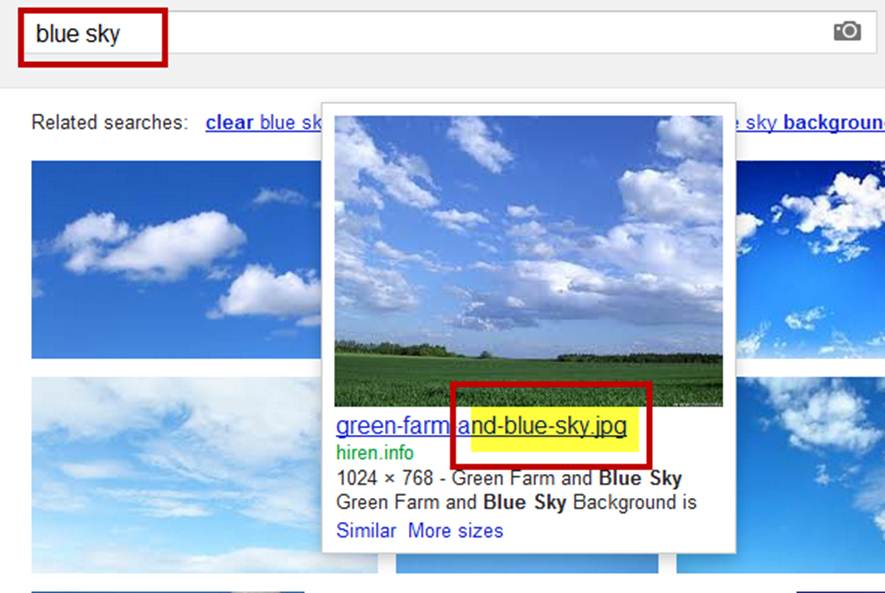So you have a photoblog or videos embedded within your site that has great information and superb content, but there’s a catch. Search engines can’t interpret and understand images or videos as easily as they can process textual content. In fact, a webpage that has a video embedded in it with no textual content is equivalent to a blank webpage for the concrete reason that search engines can’t parse and process the video embedded within your page.
It is far easier to optimize textual content and get ranked for the keywords you want, but as far as images and videos are concerned, you have to follow some conventions and techniques to increase their visibility in search engines.
There are two main advantages of optimizing non-textual content. First, you get a diverse range of organic traffic, from Google Images to YouTube to Google Universal search to meta search engines and other sources. Second, search engines do give a special emphasis to multimedia content, and if your “varied content” attracts a good amount of traction, it helps to significantly improve the overall reputation and trust of your site.
Noted below are some best practices for optimizing images and video content, plus what you should do to improve your page’s visibility if the page in question has very little textual content.
Alt Tags
Alt tags are the heart and soul of any image because this tag tells search engines what this image is all about. Here is how an alt tag is used to describe an image:
<img src=”red-rose.jpg” alt=”Red Rose”/>
When using an alt tag, remember the following points:
- Briefly describe what the image is all about. Do not write an entire paragraph and overwhelm search engines with exhaustive information.
- A good alt tag is short, meaningful, easy to understand, and flows. The combination of words should convey a meaning, purpose, attribute, location, or other relevant details. In short, it must be specific.
- Some examples of good alt tags: “Miami Beach sunrise,” “black shoes from Adidas.” and “Nikon camera D800.”
- Some example of bad alt tags: “flower” (meaningful, but unclear whether it’s a jasmine, rose, sunflower, or any other flower), “map of college” (partially meaningful, but irrelevant because the location or name of the college is not defined).
File Name
Always use a short, meaningful file name rather than using file1.jpg, picture.jpg, or image001.png. Keywords in image file names make a big difference, and search engines consider keywords along with alt tags to understand what the image is all about and what additional information or attributes this particular image may contain.
Let me illustrate this with an example. You have a stunning image of a sunrise captured in New York. You uploaded the image to your photoblog with the alt tag “Sunrise in New York” with the file name picture.jpg. The alt tag is good, but the file name is irrelevant and poor.
Now one of your friends took inspiration from your photo, and he uploaded a similar image to his website with the alt tag “Sunrise in New York City” with the file name “cloudy-blue-sky-sunrise.jpg.
Which image do you think has a chance of ranking better for the search terms “sunrise in new york cloudy sky,” assuming all other factors such as links, PageRank, etc. are the same? You guessed it. Your friend’s image has a greater chance of ranking higher.

Captions, Description, and Surrounding Text
Try to include a short caption of the image, preferably one or two sentences long. If you can write a small paragraph describing what the image is all about, write it. Never miss a chance to add textual content to the page in which the image is embedded.
Surrounding text is considered a strong signal for evaluating the usefulness and relevancy of an image. Additionally, search engines do consider captions and surrounding text to be in correlation with the image or video in question.
Page Title
The title of the page goes a long way because this is the primary signal search engines use to define the purpose of a page. If your page title is about bananas and you’ve embedded a photo with no description or alt tag, search engines will assume that the photo is related to bananas in some way or another. However, the page title should clearly define the purpose of the page and not define the purpose of the image and only the image.
For example, if your page is about the world ranking of ABC University and you’ve embedded a photo of the university, do not write a page title describing only the image. Include the name of the university and the purpose of the page, such as “World Ranking of ABC University.” That’s all. Search engines will interpret that the photo you’ve embedded is related to ABC University.
Comments
If your website has a large collection of “image only” pages with no textual content, try adding a good commenting system and encourage user participation. I highly recommend adding a Facebook comment box or the very wonderful Disqus commenting engine.
When users participate in a discussion, they will talk about the image, praise it, and describe it. This will add textual content to the page, and search engines will be able to comprehend and understand your image better.
Image Sitemaps
Use an image sitemap generator, e.g., XENU, to create an image sitemap of your website, and add the image sitemap to your Google Webmaster Tools and Bing Webmaster Tools account. Similar to a regular HTML or XML sitemap, image sitemaps help search engines discover images and learn more about the images that are embedded deep within your website.
Moreover, image sitemaps also enable you to tell Google which images are important and which images are boilerplate in nature. For example, by not adding the header image in your sitemap, you’re telling Google that the header image is just the background of the HTML template and should be ignored.
Links / Anchor Text
This is very important.
Whenever you’re linking an image from another internal page of your website or from an external domain, use proper anchor text. Avoid generic anchor text, such as “Click Here” or “See the image.” Instead, use descriptive anchor text like “Closing ceremony of Euro Cup – Photos.”
Anchor text carries a good amount of SEO value, and if you’re not using meaningful or relevant text, you’re losing a lot of Google juice that would have otherwise flown through those links.
Do read: 11 Unwritten Rules of Link Building.
Google has put up a list of guidelines and best practices for creating a great user experience through image publishing. Here is a brief synopsis:
- Not all users scroll to the bottom of a page, so consider putting your images high up on the page where they can be immediately seen.
- Good-quality photos appeal to users more than blurry, unclear images. In addition, other webmasters are much more likely to link to a good-quality image, which can increase visits to your site.
- Consider structuring your directories so that similar images are saved together.
- Specify a width and height for all images. Crunch the file size of images so that they load faster.
Video Optimization
Optimizing videos depends on whether the video in question is hosted on your site or whether you are using an external video sharing website for hosting them, e.g., YouTube, Vimeo, Blip.tv, or DailyMotion.
If you’re concerned with branding and you don’t care about bandwidth and other technical details, it feels best to host videos on your own site. Why would people host their own videos on a third-party sharing platform and let them enjoy a major portion of the traffic that you deserve?
This approach, however, has some drawbacks. First, it will be hard, if not impossible, to compete with YouTube, Vimeo, and other video sharing behemoths, who have tons of thousands of useful video content. YouTube attracts millions of visitors daily, and it is considered a very high-quality site. So if you choose to host your videos on your site, you will have to compete with YouTube, Vimeo, and other video portals. (Related: SEO Tips for Web Videos)
However, if you must use your own site to host videos, do keep the following points in mind:
- Create a video sitemap, and use this sitemap in your Google Webmaster Tools account.
- Remember to use proper video-specific tag definitions. You can learn more about video-specific tag definitions at this Google Support page.
- Use a content management system such as WordPress to power your video portal. WordPress has some excellent plugins, themes, and scripts. Optimizing your video site with WordPress should be a cake-walk.
- A sitemap is just a list for reference. You must ensure that each page that hosts a video has a proper Title tag, a properly formatted URL, and some textual content that describes the video. Similar to images, Googlebot or search spiders won’t have any clue what your video is all about, so the more textual content you have on a page, the better.
- Provide a separate RSS feed for your videos. Search bots sometimes pick up and index new content directly from the RSS feed.
- Let other users embed your video in their blogs and encourage sharing and distribution. The more your videos are shared across the Web, the more links it will attract.
Apart from bandwidth issues, a major drawback of hosting videos on your site is content plagiarism. If someone downloads your video and uploads it to YouTube, there is a high chance that the YouTube copy will rank higher (unless, of course, your page has greater trust or authority than YouTube). So watch out for content plagiarism issues, and ensure that your video content is accessible only from your website.
In any case, I would prefer YouTube for hosting videos for two reasons. First, I don’t have to worry about technicalities, bandwidth, servers, and other things. I can just focus on improving my content and let YouTube act as my vehicle.
“But the traffic goes to YouTube,” I hear you say.
True.
But when viewers watch the video on YouTube, they may very well click on the video description and arrive at your site. If your site has valuable content, the readers will keep coming back no matter which platform you’re using for distributing your content. Moreover, you earn a free, high-quality backlink from YouTube to your site, which should improve your SEO to a great extent.





